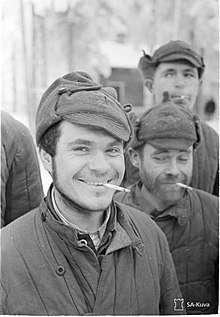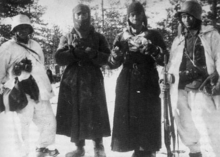Telogreika
Telogreika (Russian: телогре́йка, IPA: [tʲɪlɐˈgrʲejkə]; lit. "body warmer") or vatnik (Russian: ватник, IPA: [vˈatnʲɪk]) is a Russian kind of warm cotton wool-padded jacket. It was also a part of winter uniform first issued by the Red Army during World War II. Telogreikas continued to be issued until the late 1960s.
Variations
Earlier vatniks resembles a modern wool jacket in shape and cut, known as the 1935 vatnik. Issued extensively through 1935 to 1941, then a simplified version from 1941 and onwards.
The basic cut the uniform followed was that of a quilted jacket and quilted trousers. The trousers had a button fly and tied at the bottom of the legs. There were usually pockets on the hips of the trousers and a button pocket on the front of the trouser leg.
Telogreika jackets buttoned up the front, and the jacket sleeves buttoned closed. Early issue variants had high collars, though these were absent later on. Telogreika jackets usually had a single pocket on the front of the jacket.
The clothing was usually khaki in colour, although black uniforms were issued to tank crews and some grey variants can be seen, sewn of cotton (and later polyester-blend) fabric with a cotton wool batting inside.
The jacket and trousers usually had a ribbed design with the quilting, although this feature was absent on many of the non-Soviet issue uniforms.
Effectiveness
The telogreika was particularly effective at keeping the wearer warm in the harsh Russian Winter. When worn with valenki and an ushanka the wearer can comfortably remain warm in sub-zero temperatures for long periods. This made it the perfect uniform not just for the Red Army, but for both prisoners and guards of the Gulags.
Issue


In contrast to the usual shortages in the Red Army, soldiers received regular issues of winter clothing, as their combat effectiveness could be hampered in cold conditions otherwise. The Wehrmacht also regularly made use of captured Red Army winter uniforms, often taking them from the deceased, due to the ineffectiveness of their own winter uniforms. Similarly in the Winter War, due to a poor preparation and lack of materiel, some Finnish mobilized reserves were given a utility belt and an emblem to be attached to the hat, facetiously malli Cajander (model Cajander), and a rifle. Otherwise, they had to use their own clothes and equipment.
The telogreika faded from military issue in the early 1960s, being largely replaced by the return of the old woollen shinel greatcoat and the bushlat pea coat. In the early 1980s the introduction of the Afghanka field uniform marked the dawn of a new era in the Soviet Army. Today, the telogreika is still used in Russia and many Soviet Bloc countries by private citizens. In Russia it is particularly popular amongst night watchmen and workers in the construction industry.
Sources
- Stalin's War: Soviet Uniforms and Militaria 1941-45 by Laszlo Bekesi
- The Red Army of the Great Patriotic War, 1941-45 By Stephen J Zaloga